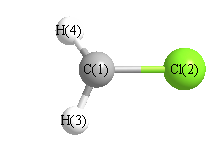Jump to
S1C2
Energy calculated at CCSD/aug-cc-pVTZ
| | hartrees |
|---|
| Energy at 0K | -498.890124 |
| Energy at 298.15K | |
| HF Energy | -498.516270 |
| Nuclear repulsion energy | 45.388443 |
The energy at 298.15K was derived from the energy at 0K
and an integrated heat capacity that used the calculated vibrational frequencies.
Vibrational Frequencies calculated at CCSD/aug-cc-pVTZ
| Mode Number |
Symmetry |
Frequency
(cm-1) |
Scaled Frequency
(cm-1) |
IR Intensities
(km mol-1) |
Raman Act
(Å4/u) |
Dep P |
Dep U |
|---|
| 1 |
A' |
3200 |
3059 |
6.67 |
|
|
|
| 2 |
A' |
1433 |
1370 |
11.96 |
|
|
|
| 3 |
A' |
854 |
816 |
30.40 |
|
|
|
| 4 |
A' |
121 |
116 |
63.32 |
|
|
|
| 5 |
A" |
3348 |
3200 |
0.20 |
|
|
|
| 6 |
A" |
1005 |
960 |
0.00 |
|
|
|
Unscaled Zero Point Vibrational Energy (zpe) 4980.4 cm
-1
Scaled (by 0.9558) Zero Point Vibrational Energy (zpe) 4760.3 cm
-1
See section
III.C.1 List or set vibrational scaling factors
to change the scale factors used here.
See section
III.C.2
Calculate a vibrational scaling factor for a given set of molecules
to determine the least squares best scaling factor.
Geometric Data calculated at CCSD/aug-cc-pVTZ
Point Group is Cs
Cartesians (Å)
| Atom |
x (Å) |
y (Å) |
z (Å) |
|---|
| C1 |
-0.005 |
1.118 |
0.000 |
| Cl2 |
-0.005 |
-0.585 |
0.000 |
| H3 |
0.052 |
1.618 |
0.950 |
| H4 |
0.052 |
1.618 |
-0.950 |
Atom - Atom Distances (Å)
| |
C1 |
Cl2 |
H3 |
H4 |
| C1 | | 1.7024 | 1.0753 | 1.0753 |
Cl2 | 1.7024 | | 2.3992 | 2.3992 | H3 | 1.0753 | 2.3992 | | 1.9007 | H4 | 1.0753 | 2.3992 | 1.9007 | |
 More geometry information
More geometry information
Calculated Bond Angles
| atom1 |
atom2 |
atom3 |
angle |
|
atom1 |
atom2 |
atom3 |
angle |
| Br2 |
C1 |
H3 |
117.701 |
|
Br2 |
C1 |
H4 |
117.701 |
| H3 |
C1 |
H4 |
124.214 |
|
Electronic energy levels
Charges, Dipole, Quadrupole and Polarizability
Jump to
S1C1
Energy calculated at CCSD/aug-cc-pVTZ
| | hartrees |
|---|
| Energy at 0K | -498.890121 |
| Energy at 298.15K | |
| HF Energy | -498.516235 |
| Nuclear repulsion energy | 45.394067 |
The energy at 298.15K was derived from the energy at 0K
and an integrated heat capacity that used the calculated vibrational frequencies.
Vibrational Frequencies calculated at CCSD/aug-cc-pVTZ
| Mode Number |
Symmetry |
Frequency
(cm-1) |
Scaled Frequency
(cm-1) |
IR Intensities
(km mol-1) |
Raman Act
(Å4/u) |
Dep P |
Dep U |
|---|
| 1 |
A1 |
3202 |
3060 |
6.50 |
|
|
|
| 2 |
A1 |
1433 |
1369 |
12.05 |
|
|
|
| 3 |
A1 |
855 |
817 |
30.14 |
|
|
|
| 4 |
B1 |
110i |
105i |
64.94 |
|
|
|
| 5 |
B2 |
3350 |
3201 |
0.25 |
|
|
|
| 6 |
B2 |
1003 |
959 |
0.00 |
|
|
|
Unscaled Zero Point Vibrational Energy (zpe) 4865.7 cm
-1
Scaled (by 0.9558) Zero Point Vibrational Energy (zpe) 4650.6 cm
-1
See section
III.C.1 List or set vibrational scaling factors
to change the scale factors used here.
See section
III.C.2
Calculate a vibrational scaling factor for a given set of molecules
to determine the least squares best scaling factor.
Geometric Data calculated at CCSD/aug-cc-pVTZ
Point Group is C2v
Cartesians (Å)
| Atom |
x (Å) |
y (Å) |
z (Å) |
|---|
| C1 |
0.000 |
0.000 |
-1.117 |
| Cl2 |
0.000 |
0.000 |
0.585 |
| H3 |
0.000 |
0.951 |
-1.619 |
| H4 |
0.000 |
-0.951 |
-1.619 |
Atom - Atom Distances (Å)
| |
C1 |
Cl2 |
H3 |
H4 |
| C1 | | 1.7020 | 1.0751 | 1.0751 |
Cl2 | 1.7020 | | 2.4000 | 2.4000 | H3 | 1.0751 | 2.4000 | | 1.9019 | H4 | 1.0751 | 2.4000 | 1.9019 | |
 More geometry information
More geometry information
Calculated Bond Angles
| atom1 |
atom2 |
atom3 |
angle |
|
atom1 |
atom2 |
atom3 |
angle |
| Br2 |
C1 |
H3 |
117.809 |
|
Br2 |
C1 |
H4 |
117.809 |
| H3 |
C1 |
H4 |
124.381 |
|
Electronic energy levels
Charges, Dipole, Quadrupole and Polarizability
